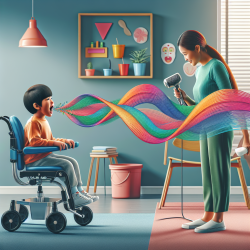As practitioners in the field of special education and speech therapy, our mission is to unlock every child's potential to communicate effectively. Recent research provides compelling evidence that specific physical postures can significantly enhance voice and speech production in children with cerebral palsy (CP). This blog delves into the transformative power of reflex inhibiting postures (R.I.P.) and how you can implement these findings to improve the lives of your students or patients.
The study titled "A Study of the Effects of Positioning on Voice and Speech Production in Young Cerebral Palsied Children" by Diane Freedman and Carmen Read, conducted at the Children's Hospital in Calgary, Alberta, explores the impact of R.I.P. on the voice production of six spastic cerebral palsied children. The results are nothing short of remarkable, demonstrating significant improvements in voice quality, particularly in frequency and intensity, after the application of these postures.
Here's how reflex inhibiting postures can make a difference and how you can apply these insights:
- Understanding R.I.P: Reflex inhibiting postures are designed to reduce spasticity in the respiratory muscles, allowing for a more normal muscle function. This, in turn, enables the child to produce a greater volume of air and strengthens vocal tone.
- Research Findings: The study showed that after positioning children in R.I.P., there was a noticeable improvement in the fundamental frequency and intensity of their voices. These changes were confirmed both by subjective evaluations from a panel of speech clinicians and objective measurements using a visicorder oscilloscope.
- Implementing R.I.P. in Therapy: Incorporating reflex inhibiting postures into your therapy sessions can be a game-changer. Start by assessing the child's current posture and muscle tone. Gradually introduce R.I.P. that are appropriate for the child, always ensuring comfort and safety. Monitor voice and speech production before and after positioning to gauge effectiveness.
- Encouraging Further Research: While this study provides a strong foundation, further research is essential to explore the full scope of benefits R.I.P. can offer. Practitioners are encouraged to document their observations and contribute to the growing body of knowledge.
The implications of this research are profound, offering a new lens through which we can view and treat speech and voice disorders in children with cerebral palsy. By integrating reflex inhibiting postures into therapy, we can make significant strides in enhancing communication abilities, ultimately improving the quality of life for these children.
For practitioners eager to deepen their understanding and refine their therapeutic approaches, this study serves as a critical resource. Embracing these insights can not only amplify your impact but also pave the way for innovations in treating speech and voice disorders in children with CP.
To read the original research paper, please follow this link: A Study of the Effects of Positioning on Voice and Speech Production in Young Cerebral Palsied Children.










